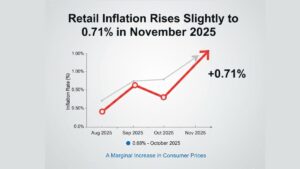The Reserve Bank of India (RBI) has identified rising food prices as the primary challenge to achieving its 4% Consumer Price Index (CPI) target, according to its ‘State of the Economy’ report. The central bank anticipates potential disruptions to the progress made in the past two months due to the firming up of various constituent prices.
I. Inflation Outlook for November and December:
The report suggests that the RBI is gearing up for an expected increase in inflation readings for November and December. It underscores the vulnerability of the 4% CPI target to food inflation, specifically highlighting rising prices in essential items like onions, tomatoes, cereals, pulses, and sugar.

II. Impact of Food Prices on CPI:
Food items carry a significant weight of approximately 40% in the CPI basket, making them a crucial factor in determining overall inflation. The report emphasizes the historical role of vegetables, constituting 13.2% of the CPI-food and beverages basket, in influencing food inflation trends. Notably, the vegetable price index experienced a 3.4% month-on-month rise in October, mainly driven by a substantial surge in onion prices.
III. Economic Progress and Challenges:
Despite the decline in the overall CPI inflation rate to 4.87% in October, the report acknowledges that challenges persist. The disinflationary monetary policy is gradually mitigating underlying inflationary pressures, leading to a notable reduction in the core inflation rate, which fell to a 43-month low.
IV. Real GDP Growth and Sectoral Performance:
The report highlights a prevailing consensus that real GDP growth is set to surpass the central bank’s projected rate of 6.5% for the second quarter. It attributes this optimism to robust bottom-line growth in sectors such as oil and gas, automobiles, and construction. The momentum of the change in GDP is expected to be higher in Q3:2023-24, supported by ebullient festival demand.
V. Global Economic Landscape:
On the global front, the report notes a slow but steady disinflationary trend despite persistently high headline inflation in many economies. It cites examples such as the easing of CPI inflation in the US and the stability of the headline personal consumption expenditure (PCE) inflation rate.
VI. Escalating Global Risks:
The report underscores an escalation in global risks due to new conflicts in West Asia and the ongoing Russia-Ukraine war. Geopolitical uncertainties have reached their highest point in 14 months, contributing to concerns about global growth and commodity prices. Consumer sentiments, especially in the US and the euro area, worsened in October amidst multiple sources of uncertainty.




 India’s Forex Reserves Rise by $1.68 Bil...
India’s Forex Reserves Rise by $1.68 Bil...
 India’s Net Direct Tax Collections Rise ...
India’s Net Direct Tax Collections Rise ...
 Retail Inflation Rises Slightly to 0.71%...
Retail Inflation Rises Slightly to 0.71%...







